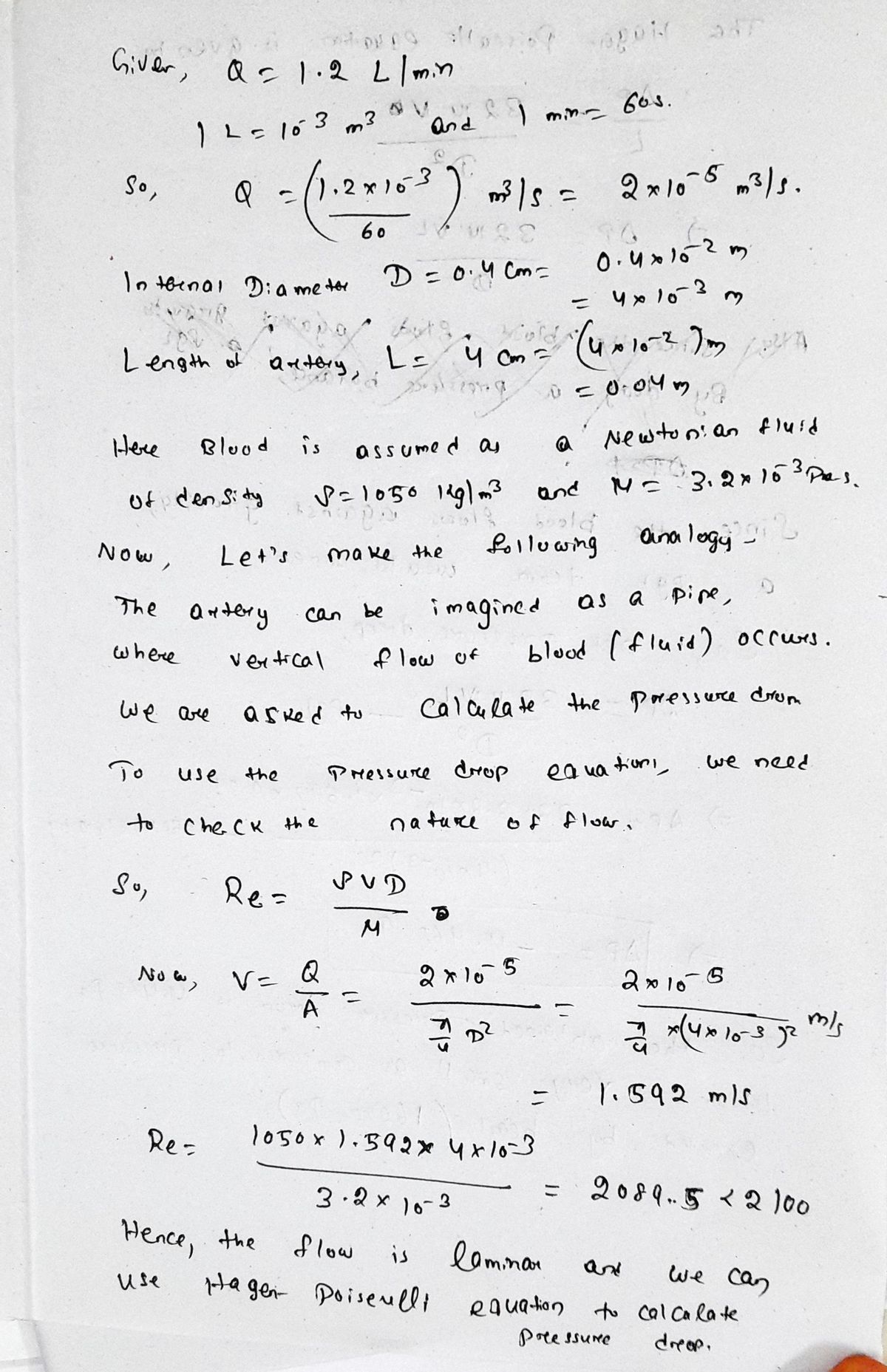(b) Compute the pressure drop in this 4 cm long section of artery when it is constricted as seen in the X-ray images. Assume that the cross section remains circular, and to keep us all on the same basis, assume that the body has some control mechanism which maintains the same volumetric flow rate through the artery. You may wish to compare these calculations with a normal pressure of 16000 Pa generated by the heart.
(b) Compute the pressure drop in this 4 cm long section of artery when it is constricted as seen in the X-ray images. Assume that the cross section remains circular, and to keep us all on the same basis, assume that the body has some control mechanism which maintains the same volumetric flow rate through the artery. You may wish to compare these calculations with a normal pressure of 16000 Pa generated by the heart.
Introduction to Chemical Engineering Thermodynamics
8th Edition
ISBN:9781259696527
Author:J.M. Smith Termodinamica en ingenieria quimica, Hendrick C Van Ness, Michael Abbott, Mark Swihart
Publisher:J.M. Smith Termodinamica en ingenieria quimica, Hendrick C Van Ness, Michael Abbott, Mark Swihart
Chapter1: Introduction
Section: Chapter Questions
Problem 1.1P
Related questions
Question
question b

Transcribed Image Text:One of your friends has experienced a circulatory problem. A physician has
diagnosed this as a problem in fluid mechanics and recommends corrective surgery.
You, as an expert in fluid mechanics, are called upon to assess the correctness of
the diagnosis: i.e., to provide a "second opinion". The physician believes that a
shoulder artery, which is normally required to carry a flow of 1.2 liters/minute of blood
has become pinched or constricted by an overgrowth of the adjacent bones. The
normal artery has an internal diameter of 0.4 cm at this position. The physician
believes that a 4 cm long section has had its cross sectional area reduced by a
factor of four. These dimensional data are taken from X-ray negatives and are
presumably correct. The stress-strain relationship for blood is described by the
Bingham plastic equation. However, let us make the simplifying assumption that
blood is a Newtonian fluid with density = 1050 kg/m³ and viscosity = 3.2x 10-3 Pa.s.

Transcribed Image Text:(b) Compute the pressure drop in this 4 cm long section of artery when it is
constricted as seen in the X-ray images. Assume that the cross section remains
circular, and to keep us all on the same basis, assume that the body has some
control mechanism which maintains the same volumetric flow rate through the artery.
You may wish to compare these calculations with a normal pressure of 16000 Pa
generated by the heart.
Expert Solution
Step 1: Making analogy between artery and pipe

Step by step
Solved in 3 steps with 2 images

Recommended textbooks for you

Introduction to Chemical Engineering Thermodynami…
Chemical Engineering
ISBN:
9781259696527
Author:
J.M. Smith Termodinamica en ingenieria quimica, Hendrick C Van Ness, Michael Abbott, Mark Swihart
Publisher:
McGraw-Hill Education

Elementary Principles of Chemical Processes, Bind…
Chemical Engineering
ISBN:
9781118431221
Author:
Richard M. Felder, Ronald W. Rousseau, Lisa G. Bullard
Publisher:
WILEY

Elements of Chemical Reaction Engineering (5th Ed…
Chemical Engineering
ISBN:
9780133887518
Author:
H. Scott Fogler
Publisher:
Prentice Hall

Introduction to Chemical Engineering Thermodynami…
Chemical Engineering
ISBN:
9781259696527
Author:
J.M. Smith Termodinamica en ingenieria quimica, Hendrick C Van Ness, Michael Abbott, Mark Swihart
Publisher:
McGraw-Hill Education

Elementary Principles of Chemical Processes, Bind…
Chemical Engineering
ISBN:
9781118431221
Author:
Richard M. Felder, Ronald W. Rousseau, Lisa G. Bullard
Publisher:
WILEY

Elements of Chemical Reaction Engineering (5th Ed…
Chemical Engineering
ISBN:
9780133887518
Author:
H. Scott Fogler
Publisher:
Prentice Hall


Industrial Plastics: Theory and Applications
Chemical Engineering
ISBN:
9781285061238
Author:
Lokensgard, Erik
Publisher:
Delmar Cengage Learning

Unit Operations of Chemical Engineering
Chemical Engineering
ISBN:
9780072848236
Author:
Warren McCabe, Julian C. Smith, Peter Harriott
Publisher:
McGraw-Hill Companies, The